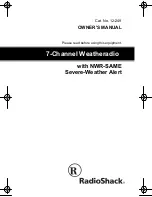
Maintenance: Relocating the Anemometer
16
Relocating the Anemometer
Using Extension Cables:
Note:
Not all cables are compatible with your Vantage Pro system. To be sure they will work, order Davis
extension cables from your dealer or directly from Davis Instruments.
If you would like to locate the anemometer more than 40’ (12 m) from the ISS, use our
extension cables #7876.
Be aware that the maximum measurable wind speed reading decreases as the total
length of cable from the anemometer to the ISS increases. If the cable length is greater
than 540' (165m), the maximum measurable wind speed may be less than 100 mph
(161 km/h).
Using the Anemometer Transmitter Kit (Wireless ISS Only)
Use the Anemometer Transmitter Kit #6330 to add an independent wireless transmitter to
your anemometer. The kit allows the anemometer to function as a transmitter station
sending wind data directly to the console, instead of transmitting via the ISS.
Remote Mounting the Solar and UV Sensors
The solar and UV sensors have a 3' (0.9 m) cable. If you wish to install these sensors away
from the ISS, you can extend the length of the sensor cables with our extension cables,
#7876.
Note:
Not all cables are compatible with your Vantage Pro system. To be sure they will work, order Davis
extension cables from your dealer or directly from Davis Instruments.
Optional Wireless Stations
Use our optional wireless sensor stations to collect additional weather measurements,
without the inconvenience of routing cables:
•
Wireless Temperature Station #6370
•
Wireless Temperature/Humidity Station #6380 or #6385
•
Wireless Leaf & Soil Moisture/Temperature Station #6343
For more details, please visit our website or see the Weather Instruments catalog. Some
information is also available in “Appendix A: Wireless Transmitter IDs” on page 19.
Maintenance
Maintaining UV and Solar Radiation Sensors
Make every effort to avoid touching the small white diffusers at the top of the sensors.
Any skin oil will reduce the sensitivity of the sensors. For accurate readings, clean the dif-
fusers at least once per month using ethyl alcohol on a soft cloth (NOT rubbing alcohol).
Due to the sensitivity of ultraviolet and solar radiation sensors it is common practice for
manufacturers to recommend re-calibration after a period of time. Here at Davis
Instruments we have seen less than 2% drift per year on the readings from these
sensors. For applications demanding higher accuracy, however, the sensors should be
calibrated once every year.
Contact Technical Support about returning your sensor for calibration. See “Contacting
Davis Instruments” on page 18.







































